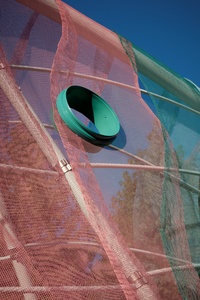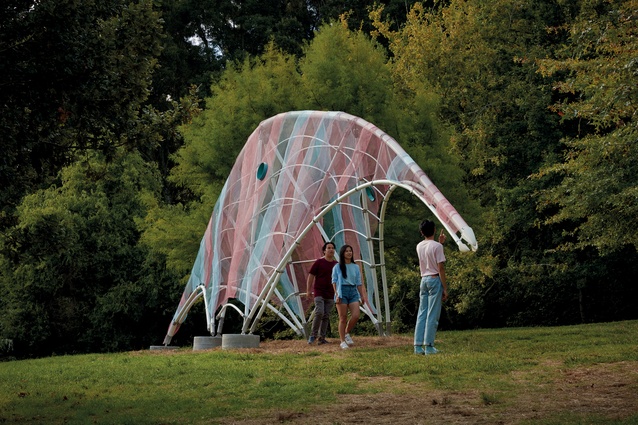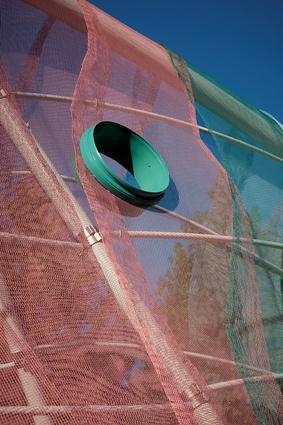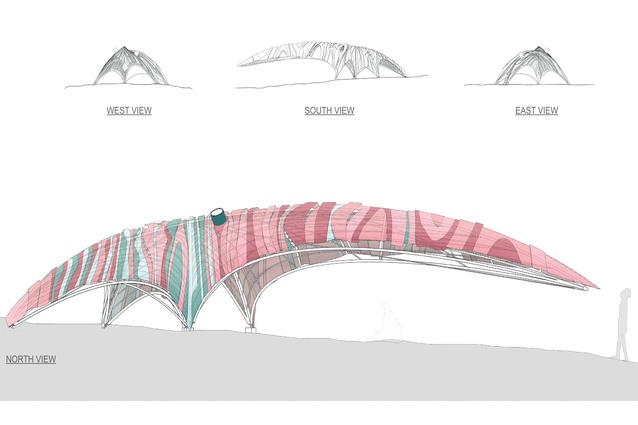Jonah: Brick Bay Folly 2018
A skeletal form of a whale, referencing the biblical story of the prophet Jonah, is the winner of the 2018 Brick Bay Folly competition. The installation was unveiled on Saturday 12 May at the Brick Bay vineyard at Snells Beach.
Designed by architectural graduates Cynthia Yuan, recently with MPM Projects, Norman Ning Wei, from Moller Architects, Kim Huynh, from Paterson Architecture Collective, and Kevin Kun Ding, currently studying at the University of Auckland’s School of Architecture and Planning and working part time at Archoffice, Jonah was created using PVC and PE piping and a fine, steel-mesh skin.
“We envisaged the concept of a beached leviathan or whale – a large, displaced being that alters its surroundings visually and spatially,” says Wei. “It creates a relationship with visitors by inviting them to inhabit its belly.”
At 14m long, the installation is representative of the mammal’s average size and features a large jaw-like cantilever, through which visitors enter, and a translucent, almost apparitional mesh skin painted, fittingly, with Resene’s ‘Deep Sea’ colour palette. In terms of spatial experience, Huynh says the first glimpse aims to instil a childlike sense of curiosity in passers-by, inviting them into a unique enclosure of space and light.

While the structure may look simple, it was anything but. The team created four prototypes off site over a six-month period, discovering improvements each time, and making design alterations to optimise performance and stability. The curvature of the structure was largely determined by the piping’s natural bending properties and the way it yielded to forces applied.
Yuan says the Folly proved to be an exercise in design, project management, construction and procurement rolled into one. This holistic experience of design and construction in miniature was a challenge in which everyday feasibility fought the integrity of the original design concept. The team members found the process both enlightening and humbling. In working with their mentors Chris Eng from Fletcher Building and Richard Harris from Jasmax, as well as colleagues and industry specialists, they were given advice on critical points of timing, parameters within which to work, and the ways in which to custom-design and prototype steel junctions for joints.

“Our lack of practical construction knowledge formed one of the biggest challenges, which was gradually resolved by help and advice from industry professionals,” says Ding. “It certainly made us reassess our skill sets as graduates.”
The Brick Bay Folly project supports young and emerging New Zealand architects or students in an accredited New Zealand architecture programme to explore the intersections between architecture and sculpture, and the increasing overlaps in references, concepts and techniques between the two disciplines. The winning entry received an overall $35,000 grant towards realising the proposed project.
“This year’s winning team reached into non-traditional materials for the structural elements of this abstracted sea creature and swathed the resulting form in colourful, lightweight mesh panels to create a translucent ‘skin’, enticing the visitor to enter this whimsical shelter,” says Folly judge, Christine Didsbury. “Once again, we are immensely grateful to our generous sponsors and know that, from the wealth of creativity displayed in this year’s many entries, the future of our country’s inspirational architecture is indeed secure.”
The selection panel comprised Richard Harris from Jasmax, Richard and Christine Didsbury and Jonathan Organ from Brick Bay, Ryan McKenzie and Karen Warman from Resene, Gus Smith from Fletcher Building, Justine Harvey from Architecture New Zealand and Jayne Kersten from the 2017 Folly-winning team that created Te Takitaki.















